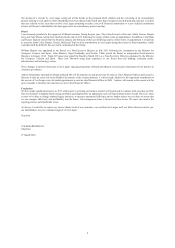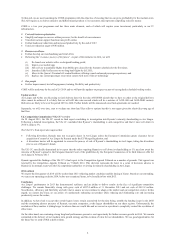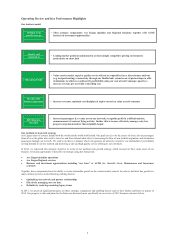Aer Lingus 2013 Annual Report Download - page 12
Download and view the complete annual report
Please find page 12 of the 2013 Aer Lingus annual report below. You can navigate through the pages in the report by either clicking on the pages listed below, or by using the keyword search tool below to find specific information within the annual report.
10
Despite these competitive conditions, Aer Lingus (including Aer Lingus Regional operations) continues to hold a strong market share of
43% of all passenger traffic at the three main Irish airports. This market share percentage is unchanged from prior year and is two
percentage points higher than the equivalent figure in 2011. This growth in market share since 2011 is particularly positive given total
passenger traffic at the three main Irish airports has increased more than 5% since 2011.
Several long haul carriers launched new transatlantic services from Dublin and Shannon in 2013. Total seat capacity on Irish routes over the
North Atlantic market increased by approximately 12.0% as United Airlines, American Airlines and US Airways added capacity through
new routes and additional seats on existing services. We, too, added capacity on the transatlantic market and successfully sold the additional
seats introduced as reflected by the 0.6 percentage point increase in our long haul load factor. Overall, we maintained our share of all seat
capacity in the Ireland to North American and Canadian market at approximately 53%.
Aer Lingus continues to respond to competitive and macroeconomic developments in our key markets by focusing on inbound markets and
traffic on the other end of ex-Ireland routes, in particular Germany, Italy and the Benelux region on short haul services and the US on long
haul services. The Group also continues to deliberately target transfer traffic through our network as a way of offsetting weaker point-to-
point demand. These initiatives are discussed further in our review of 2013 business outcomes.
Certain macroeconomic factors are also key features of the market environment in which Aer Lingus operates. In particular, fuel prices,
airport charges and FX rates are key market elements which can materially impact our operating costs.
Airport charges continued to increase in 2013. In January 2014, the UK’S Civil Aviation Authority announced that London Heathrow
charges will decrease by 1.5% per annum over the period to 2019. While this is a favourable development, we still expect London Heathrow
charges will increase for us in 2014 due to expected passenger volumes using this airport and an increase in actual charges up to the
regulatory permissible price cap in 2014.
Fuel prices were volatile during 2013, with a spread of approximately US$237 per metric tonne between the monthly average high price in
February 2013 of US$1,113 and the monthly low of US$876 in May 2013 (source: Bloomberg). To put this in context, each US$10 change
in the price per metric tonne of fuel could have a full year impact of approximatelyUS$5.0 million on our total annual fuel cost before
currency or hedging impacts are taken into account. We continue to operate a systematic fuel and FX currency hedging policy and, as at 31
December 2013, have 61% of our total expected 2014 fuel requirement hedged at US$956 per metric tonne and US$179 million of our total
expected US$ trading requirements purchased at a rate of €1 = US$1.33. This will provide us with some certainty and protection against
adverse movements in fuel price and FX rates in the year ahead.
Our operating model
We think of Aer Lingus’ operating business model in terms of how we configure our activities and resources to translate our business
objectives into performance outcomes taking account of our market environment. The key characteristics of our operating model are:
Operating model characteristic
Description
Value carrier model
Neither pure legacy nor pure low fares operating models are appropriate to serve underlying
passenger demand in our key markets. For this reason, Aer Lingus has implemented a “value
carrier” model whereby our passenger proposition is deliberately positioned between a full
service legacy carrier and a pure low cost / low fares model. Our proposition is a competitively
priced seat with additional features which passengers can select to buy or not as they choose.
Critical to our operating model is the provision of services to airports located at central locations
which enhance connectivity and convenience for our customers. Our goal is to offer this airport
selection at more competitive prices than most other European legacy carriers.
Aer Lingus seeks to leverage our unit cost advantage relative to the legacy carriers and our
superior quality service relative to low fare airlines to offer a more compelling passenger
proposition and in this way drive trading results.
Another key element of the value carrier model is to align capacity with underlying demand and
in this way maximise the return generated from our seat production.
Open network architecture
Aer Lingus provides further enhanced connectivity options to worldwide destinations through a
wide range of airline partners. This diverse range of partners epitomises our concept of “open
network architecture”, whereby our neutrality allows us to partner across alliances and offer
connectivity through major hubs to worldwide destinations on all continents. Aer Lingus is
deliberately not a member of any of the global airline alliances in order to preserve our neutrality
and in this way provide better connectivity for our customers.
We will partner with other airlines on routes where this enables us to serve underling passenger
demand more profitably than if we were to operate these routes ourselves on a standalone basis.
We offer the widest possible range of destinations, even where this involves the use of our
partners’ aircraft rather than our own aircraft to carry passengers to their final destination.
Flexibility
Aer Lingus seeks to maintain a flexible business model in order to be able to act quickly to
capitalise on emerging opportunities and to address risks and challenges as these arise. This is
reflected in the Group’s non-dogmatic approach to resource acquisition and allocation.
Aer Lingus operates a combination of mainline, wholly owned operations as well as Aer Lingus
Regional franchise operations carried out on commercial terms by another entity (Aer Arann).
The Group also adopts a balanced approach to aircraft ownership and will either acquire or lease
aircraft depending on a range of criteria including the suitability of selected ownership model to
generate a return from the opportunity in question.
Aer Lingus will lease in aircraft (e.g. Boeing 757 transatlantic flying) and lease out aircraft (e.g.
Virgin “Little Red” UK domestic operation) as appropriate.
























